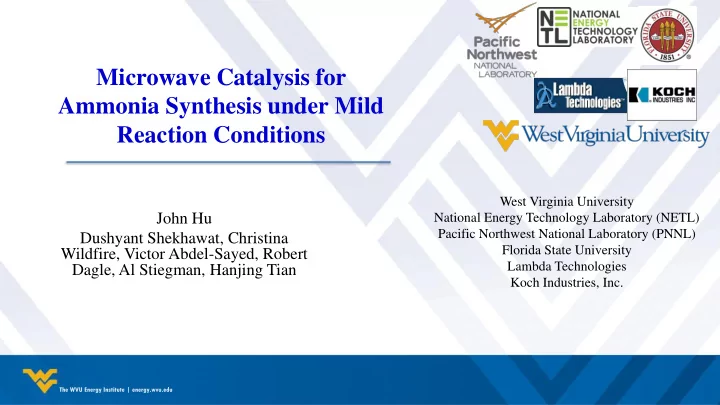

Microwave Catalysis for Ammonia Synthesis under Mild Reaction Conditions West Virginia University John Hu National Energy Technology Laboratory (NETL) Pacific Northwest National Laboratory (PNNL) Dushyant Shekhawat, Christina Florida State University Wildfire, Victor Abdel-Sayed, Robert Lambda Technologies Dagle, Al Stiegman, Hanjing Tian Koch Industries, Inc.
Background of the Research Haber-Bosch Process: the challenge of scaling down economically. The technology is fundamentally different from H-B process, having cost advantages at small scale (~100-150MW input, 25-100tpd) comparable with large scale H-B process (~1000tpd). It can be tolerant to intermittent energy supply, therefore effectively operated at variable rates of production
Microwave Catalysis-Theory Space-charge and Debye dielectric loss mechanisms for microwaves interacting with a catalyst surface for selective bond activation of reactant molecules
Thermal vs. Microwave Conversion The myth of MW inefficiency MW Assumptions: Thermal C p = 880 J/kg-K (alumina) Fluid phase & rxn negligible Bulk Q = 682 Thermal Heat losses negligible T = 800°C Yield % kJ Heater Eff ≈ 100% mW ≈ Q = 473 1 wt% Active Phase kJ Frequency = 2.45 GHz 800°C Reflected power negligible Bulk T Hot Spots Magnetron Eff = 70% MWs allows for selective heating of reacting species/sites, which can lower bulk T…can result in higher product yields 400°C for reactions that favor lower equilibrium temperatures 4
Variable Frequency Testing • Using Dielectric testing to find optimal frequencies for catalyst systems • Substrate material largely defines effect of frequency
Microwave Reactor Systems Dual E-Band Standing Wave Applicator applicator
Distributed Iron Catalyst • Catalyst design is very important for MW reactor • By separating Fe active sites, performance increased 10X • Electrons flow in “bulk” catalyst which hinders performance • Active site(metal site) size and spacing very important in MW field
Effect of Microwave Pulsing 2.0 NH3 concentration from Micro-GC,% 1.8 4% Ru/ -Al2O3 1.6 1.4 1.2 1.0 0.8 0.6 0.4 0.2 0.0 Flow Pulse 1 time Pulse 3 time (280 o C, 1 atm)
Durability Testing Micorwoave allows for shutdown/restarts in production without deactivation
Tolerance of Intermittent Power Supply Microwave catalytic ammonia synthesis under intermittent power supply (280 o C, 1 atm, GHSV=5000 h -1 , each cycle consists of one hour operation, 2 hour shutdown, 5 cycles)
TEA Results: CAPEX for Ammonia Synthesis 60,000 tons NH 3 /year scale Benchmark Base Case Worst Case Best Case H-B H 2 Treatment 5.21 2.15 2.15 2.15 NH 3 Synthesis Unit 6.19 2.95 16.99 2.35 NH 3 Recovery 5.73 16.58 28.25 16.58 NH 3 Compressors 11.2 8.13 14.48 8.13 OSBL 7.36 2.62 2.93 2.62 Total, $ million 35.70 32.43 63.91 31.84
Japan: microwave chemical plant, 10 ton/day World’s first large-scale microwave chemical plant http://mwcc.jp/en/service_technology/platform03.html Implication: Microwave ammonia synthesis-engineering scale-up risk is low
Recommend
More recommend